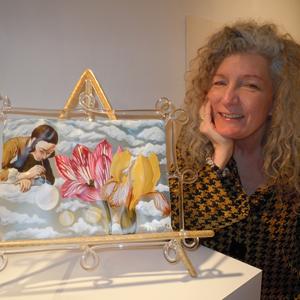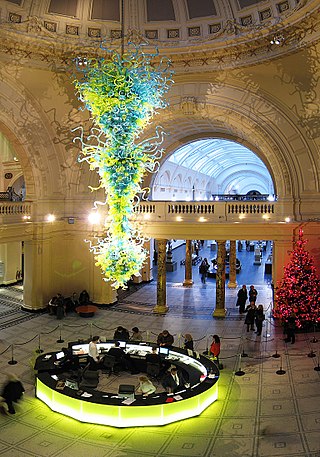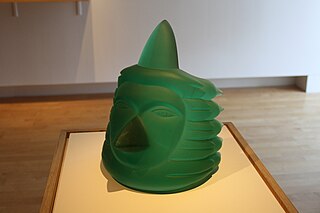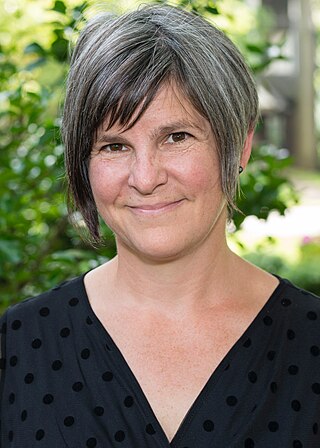
Ginny Ruffner is a pioneering American glass artist based in Seattle, Washington. She is known for her use of the lampworking technique and for her use of borosilicate glass in her painted glass sculptures.

American craft is craft work produced by independent studio artists working with traditional craft materials and processes. Examples include wood, glass, clay (ceramics), textiles, and metal (metalworking). Studio craft works tend to either serve or allude to a functional or utilitarian purpose, although they are just as often handled and exhibited in ways similar to visual art objects.
Judith Schaechter is a Philadelphia-based artist known for her work in the medium of stained glass. Her pieces often use symbolism from stained glass and Gothic traditions, but the distorted faces and figures in her work recall a 20th century German Expressionist painting style and her subject matter is secular. Shaechter's work often involves images that might be considered disturbing such as death, disease, or violence. Early Schaechter pieces, for example, such as King of Maggots and Vide Futentes make use of memento mori, symbols of death found in church architecture during medieval times.

Richard "Dick" Marquis is an American studio glass artist. One of the first Americans ever to work in a Venetian glass factory, he became a master of Venetian cane and murrine techniques. He is considered a pioneer of American contemporary glass art, and is noted for his quirky, playful work that incorporates flawless technique and underlying seriousness about form and color.

Dan Owen Dailey is an American artist and educator, known for his sculpture. With the support of a team of artists and crafts people, he creates sculptures and functional objects in glass and metal. He has taught at many glass programs and is professor emeritus at the Massachusetts College of Art, where he founded the glass program.
Fritz Dreisbach is an American studio glass artist and teacher who is recognized as one of the pioneers of the American Studio Glass Movement.

Karen LaMonte is an American artist known for her life-size sculptures in ceramic, bronze, marble, and cast glass.

Paul Marioni is an American artist who works in the medium of glass.
Sonja Blomdahl is an American blown glass artist.

Joyce J. Scott is an African-American artist, sculptor, quilter, performance artist, installation artist, print-maker, lecturer and educator. Named a MacArthur Fellow in 2016, and a Smithsonian Visionary Artist in 2019, Scott is best known for her figurative sculptures and jewelry using free form, off-loom beadweaving techniques, similar to a peyote stitch. Each piece is often constructed using thousands of glass seed beads or pony beads, and sometimes other found objects or materials such as glass, quilting and leather. In 2018, she was hailed for working in new medium — a mixture of soil, clay, straw, and cement — for a sculpture meant to disintegrate and return to the earth. Scott is influenced by a variety of diverse cultures, including Native American and African traditions, Mexican, Czech, and Russian beadwork, illustration and comic books, and pop culture.
Ann Gardner is an American glass artist known for her large-scale sculptural and architectural installations.

Beth Lipman is a contemporary artist working in glass. She is best known for her glass still-life compositions which reference the work of 16th- and 17th-century European painters.
Debora Moore is a contemporary glass artist. She is best known for her glass orchids.

Ann Wolff is a glass artist who lives and works in both Gotland, Sweden, and in Berlin, Germany. Wolff's blown, engraved, and cast work explores the lives of women, their relationship with one another, and their position in society. She is considered one of the founders of the international Studio Glass movement.

Florence Lisa Resnikoff was an American artist and educator in the fields of metals and jewelry.
Susan Stinsmuehlen-Amend is a glass and mixed media artist who lives and works in Ojai, California.

Anna Mlasowsky is a German artist. She is known for her experimental and boundary pushing work in glass and is recognized as one of the leading female artist working in glass today.
Flora C. Mace is an American glass artist, sculptor, and educator. She was the first woman to teach at Pilchuck Glass School. Since the 1970s, her artistic partner has been Joey Kirkpatrick and their work is co-signed. Mace has won numerous awards including honorary fellow by the American Craft Council (2005).
Joey Kirkpatrick is an American glass artist, sculptor, wire artist, and educator. She has taught glassblowing at Pilchuck Glass School. Since the 1970s, her artistic partner has been Flora Mace and their work is co-signed. Kirkpatrick has won numerous awards including honorary fellow by the American Craft Council (2005).
April Surgent is an American glass artist. She studied at the Pilchuck Glass School and the Australian National University. In 2009 she received a Behnke Foundation Neddy Fellowship. In 2013 Surgent participated in the National Science Foundation Antarctic Artists and Writers Program. In 2016 she received a United States Artists fellowship. In 2018 Surgent work was featured in the exhibit Cameo Glass in Context: Charlotte Potter and April Surgent at the Wichita Art Museum. Her work is in the collection of the Corning Museum of Glass, and the Museum of Glass










